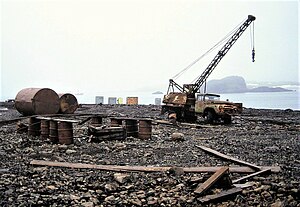Protocol on Environmental Protection to the Antarctic Treaty
The Protocol on Environmental Protection to the Antarctic Treaty, also known as the Antarctic-Environmental Protocol, or the Madrid Protocol, is part of the Antarctic Treaty System. It provides for comprehensive protection of the Antarctic environment and dependent and associated ecosystems.

It was concluded in Madrid and opened for signature on October 4, 1991 and entered into force on January 14, 1998. The treaty will be open for review in 2048.
Key Articles of the Treaty
- Article 3 states that protection of the Antarctic environment as a wilderness with aesthetic and scientific value shall be a "fundamental consideration" of activities in the area.
- Article 7 states that "Any activity relating to mineral resources, other than scientific research, shall be prohibited." This provision contrasts with the rejected Convention on the Regulation of Antarctic Mineral Resource Activities, which would have allowed mining under the control and taxation of an international managing body similar to the International Seabed Authority.
- Article 8 requires environmental assessment for all activities, including tourism.
- Article 11 creates a Committee for Environmental Protection for the continent.
- Article 15 calls for member states to be prepared for emergency response actions in the area.
- Articles 18-20 arrange for arbitration of international disputes regarding Antarctica.
- Article 25(5) states that the Article 7 ban on mining may not be repealed unless a future treaty establishes a binding regulatory framework for such activity.
State parties
As of May 2013, the protocol has been ratified by 34 parties — Argentina, Australia, Belarus, Belgium, Brazil, Bulgaria, Canada, Chile, the People's Republic of China, Czech Republic, Ecuador, Finland, France, Germany, Greece, India, Italy, Japan, South Korea, Netherlands, New Zealand, Norway, Peru, Poland, Romania, Russia, South Africa, Spain, Sweden, Ukraine, United Kingdom, United States, and Uruguay.[1]
A further 11 states — Austria, Colombia, Cuba, Denmark, Guatemala, Hungary, North Korea, Papua New Guinea, Slovakia, Switzerland, and Turkey — have signed but not yet ratified it.
Campaign
The treaty followed a lengthy campaign by Greenpeace, including the construction of an Antarctic base from 1987-1991.[2][3] Greenpeace claims the protocol as a victory.[4]
References
![]() This article incorporates public domain material from The World Factbook (2024 ed.). CIA. (Archived 2003 edition.)
This article incorporates public domain material from The World Factbook (2024 ed.). CIA. (Archived 2003 edition.)
- ^ Adopted by SATCM XI-4 (Madrid, 1991)
- ^ Donald, Rothwell. "The Antarctic Treaty System: Resource Development, Environmental Protection or Disintegration?" (PDF). 1990. The Arctic Journal. Retrieved 20 February 2013.
- ^ Fogg, Gordon. "A history of Antarctic science". Studies in Polar Research 1992. Cambridge University Press. Retrieved 20 February 2013.
- ^ "1991 - International Treaty saves the Antarctic from deadly threat". 2011. Greenpeace International. Retrieved 20 February 2013.
External links
- Protocol on Environmental Protection to the Antarctic Treaty, Secretariat of the Antarctic Treaty
- Original Text of Treaty, PDF format.
- Ratifications.
- Environmental treaties
- Antarctica agreements
- 1998 in Antarctica
- Treaties concluded in 1991
- Treaties entered into force in 1998
- Environment of Antarctica
- 1998 in the environment
- Treaties of Argentina
- Treaties of Australia
- Treaties of Belgium
- Treaties of Brazil
- Treaties of Bulgaria
- Treaties of Chile
- Treaties of the People's Republic of China
- Treaties of Ecuador
- Treaties of Finland
- Treaties of France
- Treaties of Germany
- Treaties of India
- Treaties of Italy
- Treaties of Japan
- Treaties of South Korea
- Treaties of the Netherlands
- Treaties of Norway
- Treaties of Peru
- Treaties of Poland
- Treaties of Russia
- Treaties of South Africa
- Treaties of Spain
- Treaties of Sweden
- Treaties of the United Kingdom
- Treaties of the United States
- Treaties of Uruguay
- Treaties of New Zealand
- Treaties of Belarus
- Treaties of Canada
- Treaties of the Czech Republic
- Treaties of Romania
- Treaties of Ukraine
- Treaties of Greece
- 1991 in Spain
